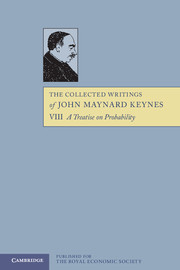Book contents
- Frontmatter
- Contents
- General Introduction
- Editorial Foreword by R. B. Braithwaite
- Editorial Note
- Preface to the First Edition
- I FUNDAMENTAL IDEAS
- 1 THE MEANING OF PROBABILITY
- 2 PROBABILITY IN RELATION TO THE THEORY OF KNOWLEDGE
- 3 THE MEASUREMENT OF PROBABILITIES
- 4 THE PRINCIPLE OF INDIFFERENCE
- 5 OTHER METHODS OF DETERMINING PROBABILITIES
- 6 THE WEIGHT OF ARGUMENTS
- 7 HISTORICAL RETROSPECT
- 8 THE FREQUENCY THEORY OF PROBABILITY
- 9 THE CONSTRUCTIVE THEORY OF PART I SUMMARISED
- II FUNDAMENTAL THEOREMS
- III INDUCTION AND ANALOGY
- IV SOME PHILOSOPHICAL APPLICATIONS OF PROBABILITY
- V THE FOUNDATIONS OF STATISTICAL INFERENCE
- Bibliography
- Index
5 - OTHER METHODS OF DETERMINING PROBABILITIES
from I - FUNDAMENTAL IDEAS
Published online by Cambridge University Press: 05 November 2012
- Frontmatter
- Contents
- General Introduction
- Editorial Foreword by R. B. Braithwaite
- Editorial Note
- Preface to the First Edition
- I FUNDAMENTAL IDEAS
- 1 THE MEANING OF PROBABILITY
- 2 PROBABILITY IN RELATION TO THE THEORY OF KNOWLEDGE
- 3 THE MEASUREMENT OF PROBABILITIES
- 4 THE PRINCIPLE OF INDIFFERENCE
- 5 OTHER METHODS OF DETERMINING PROBABILITIES
- 6 THE WEIGHT OF ARGUMENTS
- 7 HISTORICAL RETROSPECT
- 8 THE FREQUENCY THEORY OF PROBABILITY
- 9 THE CONSTRUCTIVE THEORY OF PART I SUMMARISED
- II FUNDAMENTAL THEOREMS
- III INDUCTION AND ANALOGY
- IV SOME PHILOSOPHICAL APPLICATIONS OF PROBABILITY
- V THE FOUNDATIONS OF STATISTICAL INFERENCE
- Bibliography
- Index
Summary
1. The recognition of the fact, that not all probabilities are numerical, limits the scope of the principle of indifference. It has always been agreed that a numerical measure can actually be obtained in those cases only in which a reduction to a set of exclusive and exhaustive equiprobable alternatives is practicable. Our previous conclusion that numerical measurement is often impossible agrees very well, therefore, with the argument of the preceding chapter that the rules, in virtue of which we can assert equiprobability, are somewhat limited in their field of application.
But the recognition of this same fact makes it more necessary to discuss the principles which will justify comparisons of more and less between probabilities, where numerical measurement is theoretically, as well as practically, impossible. We must, for the reasons given in the preceding chapter, rely in the last resort on direct judgment. The object of the following rules and principles is to reduce the judgments of preference and relevance, which we are compelled to make, to a few relatively simple types.
2. We will enquire first in what circumstances we can expect a comparison of more and less to be theoretically possible. I am inclined to think that this is a matter about which, rather unexpectedly perhaps, we are able to lay down definite rules. We are able, I think, always to compare a pair of probabilities which are (i) of the type ab/h and a/h, or (ii) of the type a/hh1 and a/h, provided the additional evidence h1 contains only one independent piece of relevant information.
- Type
- Chapter
- Information
- The Collected Writings of John Maynard Keynes , pp. 70 - 76Publisher: Royal Economic SocietyPrint publication year: 1978



